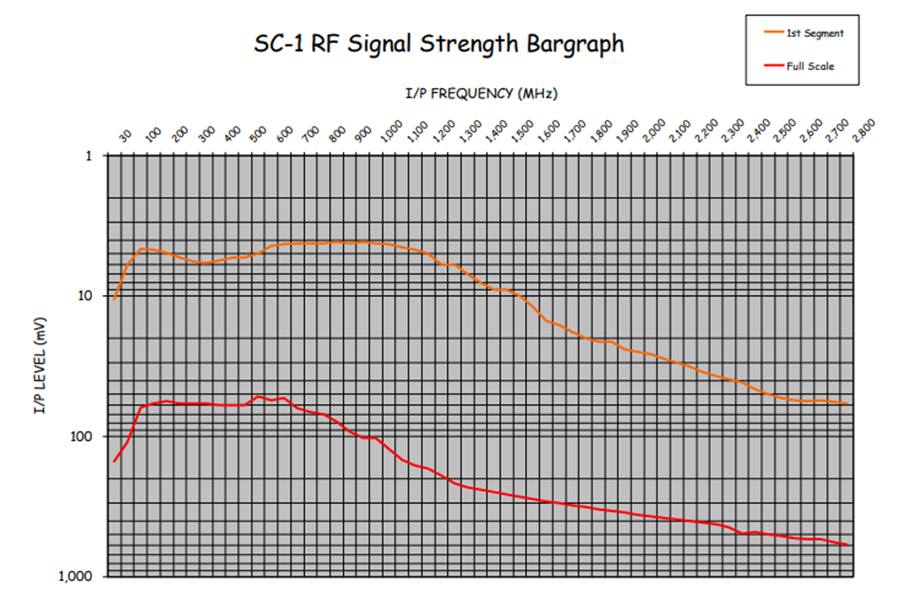L´ Aceco SC-1 è un frequenzimetro portatile molto compatto per misurare segnali analogici e digitali da 30 Mhz a 2.8 Ghz quindi in grado di "scovare" eventuali "cimici" anche basate su tecnologia GSM/DECT, fornito con antenna telescopica attacco BNC con possibilità di connettere una eventuale opzionale mini antenna direttiva portatile, batteria ricaricabile e caricabatteria.
Questo dispositivo permette di leggere la frequenza ma non dispone di demodulatore o decodificatore del segnale quindi non può ascoltare la comunicazione.
.jpg)
Scarica manuale PDF in inglese
Specifications
|
Impedance:
Frequency range:
Sensitivity:
Max. input:
Resolution:
Timebase:
Weight:
Size:
Case:
Battery:
Power:
|
50 Ohms (BNC Socket) VSWR less than 2:1
30 MHz - 2.8 GHz
less than 5 mV
15 dBm
10 KHz for digital signals or On/Off Keying &
1 KHz for Analog Signals
Less than 1 PPM at room temperature
210 g
80 mm high x 68 mm wide x 31 mm deep
Stamped aluminum with black anodized finish
Internal 4 x AA 600 mAH NiCd pack
9 VDC 300 mA
|
|

Features
- 7 digit Liquid Crystal Display
-
Frequency counter for digital, on/off keying and analog signals with a minimum pulse width of 250 uS.
-
Ultra sensitive synchronous detector - 16 section bargraph to show RF signal strength (-35dBm to 0dBm)
-
Two range positions - the 1 GHz position for frequencies between 30 MHz and 0.8 GHz and the 2.8 GHz position for frequencies between 500 MHz and 2.8 GHz.
-
Squelch adjustment for input signals
-
Hold switch to lock display
-
Low battery indicator
- Low power consumption (Average 5 hour battery life)
Controls
- SQL Knob - This knob turns the RF counter on and tunes the squelch up or down to set the signal strength for reception.
- Range Switch - This should be switched to the 1 GHz position for frequencies between 30 MHz and 0.8 GHz and switched to the 2.8 GHz position for frequencies between 500 MHz and 2.8 GHz.
- Hold Button - This holds the current display and stops the counter from counting.
- Calibration - The calibration adjustment opening is located on the front panel of the counter. This allows access to the trimmer capacitor that provides about a 10 PPM adjustment range of the time base oscillator. This is not usually necessary but to do so read a signal of a known frequency before adjusting the trimmer for correct frequency display. If you calibrate at 4.1943 MHz or above then the counter will be more accurate.
Hints and Tips
- NiCd Operation
This RF counter can operate for up to six hours from its fully charged NiCd batteries. They are charged when the unit is plugged into the supplied AC/DC adapter. Full recharge will occur over 12 to 16 hours. Before recharging the batteries you should be deep cycled occasionally by allowing them to completely discharge to maintain maximum battery capacity. The NiCd batteries should last for several years. However, it is a good idea to check them every twelve months for signs of corrosion or leakage. Always replace the whole set if any one cell fails.
-
Signal Input
When using the RF counter with an antenna for signal pick up, random frequencies may appear on the display. This is quite normal and is caused by the high gain of the receiver circuits, which amplify noise in the absence of a strong readable signal. Never get the unit too close to a transmitter as internal damage will result.
-
Antenna Selection
The supplied telescopic antenna is best for general purpose use. This is because its length can be adjusted to suit the frequency required. Usually you will want a shorter antenna for UHF and a fully extended one for VHF / HF.
-
Reception Distance From Transmitter
The distance from which you will be able to receive frequencies will depend upon the type and location of the transmitting antenna, transmitter output power and the frequency in use.
|